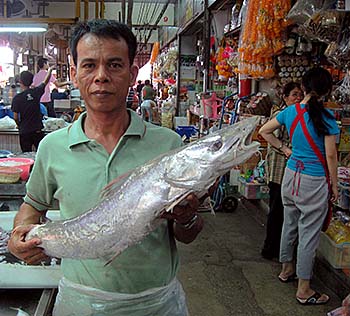Ratchaburi
Between Nakhon Pathom and Phetchaburi lies the Province of Ratchaburi, with it's capital town of the same name. Ratchaburi (translatable to King's City) is one of Thailand's oldest places; traces of Bronze Age settlements were found in the province. In the middle ages, Ratchaburi was a center of the Dvaravati Culture. Having a long history and situated at the northern end of the Malay Peninsula, nowadays the place is of no particular significant importance anymore.

Ratchaburi's clocktower in the inner town; it's a not too big place. Image by Asienreisender, 8/2010
To the west, the province stretches into the Tenasserim Mountains, who form here the border to Burma/Myanmar. To the east it's merely 80km to the Thai capital Bangkok. The largest river is Nam Mae Klong (river), which flows directly through the town. The plains are crisscrossed by an extensive net of canals (klongs).
A very small part of the province's population are hill tribes, particularly Karen, who live in the mountains. Other minorities are Mon, Laotians, Khmer and Lawa. As everywhere in Thailand, a significant part of the people is Chinese.
Like Nakhon Pathom, once the place was a coastal town at the shores of the Gulf of Thailand. Silt sedimentation filled the coastal stretches of the sea over 30km, changing it into a fertile, alluvial plain. In the middle ages, being a Dvaravati settlement, Ratchaburi lied along a trade route between India, China and Vietnam.

As always in Thai cities, on the freshmarket one get's a variety of fish. Here it's, additionally to freshwater fish, also seawater fish from the Gulf of Thailand. Image by Asienreisender, 8/2010
When imperial Angkor conquered central Thailand, Ratchaburi fell into the hands of the Khmer. In the 13th century, the place was for the first time conquered by a Thai army from Sukothai, in the reign of famous king Ramkhamhaeng. After the Sukothai era followed the Ayutthaya era, which ended in 1767. When Ayutthaya was destroyed by a Burmese army, Ratchaburi was for a short time under Burmese control, but then reconquered by a Thai army under general Taksin in 1768. Another Burmese army on the way to Bangkok was anyhow stopped here in 1785. In the early 20th century the place got a railway connection to the southern railway which leads now all the way down to Singapore.
The province's sights are Wat Mahathat, a prominent temple who dates back to the Dvaravati era, a national museum, a floating market (Damnoen Saduak) and some landscapes in the Tenasserim Mountains, among them large bat caves like at Khao Bin and the Chomphon Cave.

Ratchaburi Railway Station and, a few hundred meters north, the railway bridge over the Nam Mae Klong. Images and photocomposition by Asienreisender, 8/2010, 2016